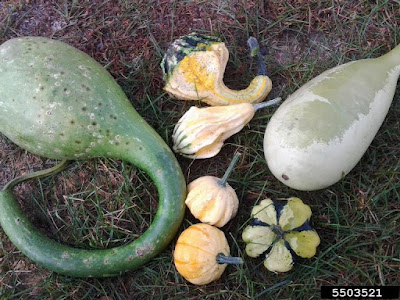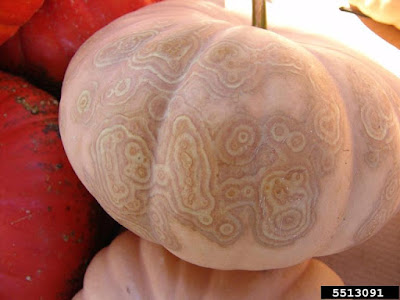Diagnosis of fruit rots, especially at this point in the season (and a few rainy days!) can be tricky. Once the fruit is compromised, bacteria and fungi from the environment want to join in on the decay. While getting fruit into the diagnostic clinic is tricky, if you are seeing widespread damage, it is a good idea to make a trip to St. Paul.
Fruit appears water soaked after a cold night? Think frost damage
Nights are getting cooler, and remember that low spots in the field can have extra cold microclimates. If you are seeing pumpkins and squash, either in the field or waiting for sale, with water soaked areas or depressions that appear after a cool night, they may be suffering from chilling injury.
The weather can turn on a dime, and it can be hard to get everything out of the field. You can’t prevent early frost, but harvesting quickly and proper storage for help. If you have a display of pumpkins that are spend the night outdoors, covering them during a cool night can give them enough protection to get through some cold nighttime temperatures.
Corky tan texture? Think oedema
Were you in a part of the state that got a lot of rain while pumpkins and squash were maturing? A large influx of water can lead to cells in the fruit burst and scabbing over – known as oedema. You may see more in low spots in the fields and where the fruit touch the ground, but if there is an influx of water, it can happen anywhere.
While the pumpkins are ugly, generally spots with oedema scab over and the fruit holds up. They may break down more quickly than unscarred pumpkins, as the oedema can create openings for opportunistic pathogens.
Pumpkins discolored and bumpy? Think viruses
Preventing viruses is tricky – it takes one infected aphid feeding for a short time to move diseases around. Sometimes, the instinct is to protect plants by using insecticides, but this can have the opposite effect. In many cases, aphid numbers are kept low by predatory, beneficial insects and broad spectrum insecticides can kill both pests and predators. The aphids can grow their numbers and make their way back into the field quickly, while beneficial insects take much longer to rebound. I am prone to attribute sporadic virus-infected fruit to bad luck as much as anything else. If you were burned by aphids this year, make a plan to scout for aphids as you scout for cucumber beetles, squash bugs, and squash vine borer.
Deeply colored concentric rings? Think gummy stem blight
Gummy stem blight, also known as black rot, is caused by a fungus and enter plants through wounds. Harvest-time symptoms include water-soaked areas with concentric rings. The pathogen often goes hand-in-hand with cucumber beetles and squash bugs – the wounds they cause make it easier for the fungus to get into the plant.
If you are seeing these types of symptoms, try to confirm it with a lab diagnosis. Rotate for at least two years, and revisit how you manage insects – scouting and actively managing these insects should significantly reduce how much of this problem you see.
Melted down fruit with powdered sugar spores? Think phytophthora
Maybe one of the trickiest plant diseases to deal with, signs of phytophthora include premature plant death, especially in the wettest areas of the field. Infected fruit meltdown and often are covered in what looks like powdered sugar. This damage often starts where the fruit touches the ground then works its way upward.
This is also a disease where a fruit can look fine at harvest, and totally melt down in a bin or while on display.
If this is what you’re seeing, confirm with the lab, as this disease will change the way you do a lot of things in your growing space. It lives a long time in the soil and can infect things like peppers and beans, as well as vine crops. For more info on specific management, see the UMN page on the disease.

.jpg)
.jpg)


Comments
Post a Comment